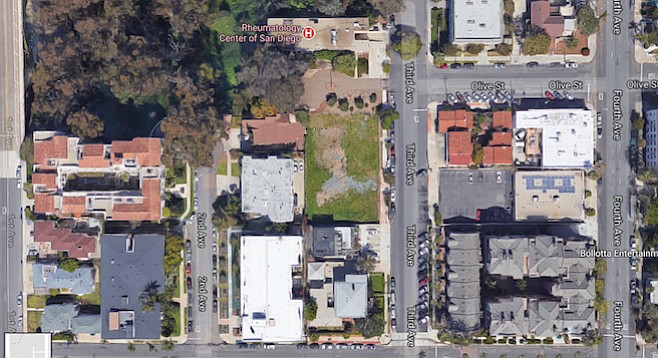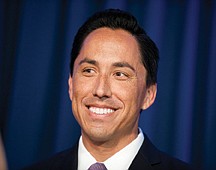 Facebook
Facebook
 X
X
 Instagram
Instagram
 TikTok
TikTok
 Youtube
Youtube

The draft plans for Olive Street Park met resistance Thursday evening (October 26th) as people who live adjacent to the 80´ x 100´ plot of land raised a ruckus over not being included or notified of the planning.
Besides neighbors, an increasingly frustrated number of people believe that the far corner of a tot-lot neighborhood park may not be the best place to put the memorial for the 8000 San Diego residents who died of the disease in the epidemic’s early years.

Two members of the volunteer AIDS memorial task force — which includes the mayor’s wife and a member of his staff — confirmed what members of the gay community and the Bankers Hill community had long suspected: the city chose the Bankers Hill park location long before the “public” process at the behest of then–city councilmember Todd Gloria. Gloria left the city council and was sworn in as a California assemblyman in December 2016, while the task force has maintained they voted on the site in September 2017.
Kurt Carlson of architecture firm KTUA unveiled the plan — without the design for the AIDS memorial but with a playground, a grassy area at least as large as the playground, and an amphitheater at the north end. It became apparent that the park came out of political sausage-making. Two members of the task force explained how the memorial came to be set into Olive Street Park.
“It’s been a stinky process that has left a really bad taste in many people’s mouths,” Roy McMakin said. “If you want to commission a memorial to AIDS, and that’s a profound and meaningful thing...it should be done with real transparency.”
The task-force co-chair, Nicole Murray Ramirez, outlined how the task force involved the gay community in the planning. But she also confirmed what many people had suspected: the decision to site it in the neighborhood park was made in private, before the task force “publicly voted” on it in September.
“You have to remember that councilman Todd Gloria came to us and said, ‘I know where this can be,’” Ramirez said. “‘Like it or not, this can be at the Olive Street Park we haven’t even built yet.’… We said, ‘This is great, we’ll have these meetings’ and we did…. We were given this, handed this by our councilman — your councilman.”
Ramirez said she understood that the neighbors may not want a public memorial in their midst. “I want you to know we did not come up with Olive Street Park. It was presented to us as a task force,” she added.
Later, task-force member Susan Jester confirmed that “Todd came to us with the site and we thought it was a great idea.”
Another of the questionable assertions: that the funds from selling the Brad Truax house will pay for the park and memorial. (The Truax house is the site of the city’s first AIDS hospice, which the city sold to developers.) Advocates had challenged that because they understand the Truax house was purchased with state road tax money and the money from the sale, by law, must return to state coffers.
“The park came over [to us] funded with developer impact funds,” Carlson said. “The Truax house funded the additional costs to this project.”
Gail Garwood, who lives near the vacant lot, was among those who listened to the contradicting stories of how the park is being funded. “We don’t need an AIDS memorial in order to fund a neighborhood park,” Garwood said. “It’s not deserving to all the people who died of AIDS to give them an itty-bitty memorial in a neighborhood park. It should be in an area that has amenities and services.”
The park was short $150,000, not completely funded until the sale of the Truax house, as had been earlier asserted. “I’ll give you the $150,000,” Garwood declared.
“The memorial was designed with the thought in mind that it would be a quiet, contemplative space for reflection,” said Jen LeBron, a member of the mayor’s staff who served on the AIDS Memorial Task Force. “While it may be a gathering place, it will not be a gathering place with people running around yelling and screaming…. I understand that these two uses are, in the minds of some folks here, are a little bit different.”
LeBron tried to assert that the park was unfunded until the mayor decided to fund it. But she was scolded by attendees over the “monkey business” around the Truax house sale.
“There’s 8000 people who died of AIDS in a most critical part of the city’s history — why would you hide [the memorial] here when you could openly put it where we could have masses of people coming from all over the city, the country, the world?” asked neighbor Rod Wright. “You hit the nail on the head when you said they’re going to get it here whether the community wants it or not.”
The KTUA plan — the favorite of proposed designs, didn’t include the AIDS memorial, though it was obvious that the plan has almost the same footprint as the memorial design. The plan includes placing sharp edged rocks to keep the homeless from setting up camp in the less visible parts of the park.
“That area is a major dumping area,” said Jenniffer Hasso, who lives by the northwestern edge of the land that was donated for a park more than 100 years ago. “We remove mattresses, needles — everything you can imagine. The city hasn’t been there once, not once to clean up.”
Hasso and her neighbors repeatedly interrupted the presentation, arguing that the new park would become another campsite for homeless people.
“I don’t see any plan for security and on top of that you’re adding noise to an already problematic area where we live,” Hasso declared. “A place for 70 people during the day is a place for 70 people to sleep at night.”


The draft plans for Olive Street Park met resistance Thursday evening (October 26th) as people who live adjacent to the 80´ x 100´ plot of land raised a ruckus over not being included or notified of the planning.
Besides neighbors, an increasingly frustrated number of people believe that the far corner of a tot-lot neighborhood park may not be the best place to put the memorial for the 8000 San Diego residents who died of the disease in the epidemic’s early years.

Two members of the volunteer AIDS memorial task force — which includes the mayor’s wife and a member of his staff — confirmed what members of the gay community and the Bankers Hill community had long suspected: the city chose the Bankers Hill park location long before the “public” process at the behest of then–city councilmember Todd Gloria. Gloria left the city council and was sworn in as a California assemblyman in December 2016, while the task force has maintained they voted on the site in September 2017.
Kurt Carlson of architecture firm KTUA unveiled the plan — without the design for the AIDS memorial but with a playground, a grassy area at least as large as the playground, and an amphitheater at the north end. It became apparent that the park came out of political sausage-making. Two members of the task force explained how the memorial came to be set into Olive Street Park.
“It’s been a stinky process that has left a really bad taste in many people’s mouths,” Roy McMakin said. “If you want to commission a memorial to AIDS, and that’s a profound and meaningful thing...it should be done with real transparency.”
The task-force co-chair, Nicole Murray Ramirez, outlined how the task force involved the gay community in the planning. But she also confirmed what many people had suspected: the decision to site it in the neighborhood park was made in private, before the task force “publicly voted” on it in September.
“You have to remember that councilman Todd Gloria came to us and said, ‘I know where this can be,’” Ramirez said. “‘Like it or not, this can be at the Olive Street Park we haven’t even built yet.’… We said, ‘This is great, we’ll have these meetings’ and we did…. We were given this, handed this by our councilman — your councilman.”
Ramirez said she understood that the neighbors may not want a public memorial in their midst. “I want you to know we did not come up with Olive Street Park. It was presented to us as a task force,” she added.
Later, task-force member Susan Jester confirmed that “Todd came to us with the site and we thought it was a great idea.”
Another of the questionable assertions: that the funds from selling the Brad Truax house will pay for the park and memorial. (The Truax house is the site of the city’s first AIDS hospice, which the city sold to developers.) Advocates had challenged that because they understand the Truax house was purchased with state road tax money and the money from the sale, by law, must return to state coffers.
“The park came over [to us] funded with developer impact funds,” Carlson said. “The Truax house funded the additional costs to this project.”
Gail Garwood, who lives near the vacant lot, was among those who listened to the contradicting stories of how the park is being funded. “We don’t need an AIDS memorial in order to fund a neighborhood park,” Garwood said. “It’s not deserving to all the people who died of AIDS to give them an itty-bitty memorial in a neighborhood park. It should be in an area that has amenities and services.”
The park was short $150,000, not completely funded until the sale of the Truax house, as had been earlier asserted. “I’ll give you the $150,000,” Garwood declared.
“The memorial was designed with the thought in mind that it would be a quiet, contemplative space for reflection,” said Jen LeBron, a member of the mayor’s staff who served on the AIDS Memorial Task Force. “While it may be a gathering place, it will not be a gathering place with people running around yelling and screaming…. I understand that these two uses are, in the minds of some folks here, are a little bit different.”
LeBron tried to assert that the park was unfunded until the mayor decided to fund it. But she was scolded by attendees over the “monkey business” around the Truax house sale.
“There’s 8000 people who died of AIDS in a most critical part of the city’s history — why would you hide [the memorial] here when you could openly put it where we could have masses of people coming from all over the city, the country, the world?” asked neighbor Rod Wright. “You hit the nail on the head when you said they’re going to get it here whether the community wants it or not.”
The KTUA plan — the favorite of proposed designs, didn’t include the AIDS memorial, though it was obvious that the plan has almost the same footprint as the memorial design. The plan includes placing sharp edged rocks to keep the homeless from setting up camp in the less visible parts of the park.
“That area is a major dumping area,” said Jenniffer Hasso, who lives by the northwestern edge of the land that was donated for a park more than 100 years ago. “We remove mattresses, needles — everything you can imagine. The city hasn’t been there once, not once to clean up.”
Hasso and her neighbors repeatedly interrupted the presentation, arguing that the new park would become another campsite for homeless people.
“I don’t see any plan for security and on top of that you’re adding noise to an already problematic area where we live,” Hasso declared. “A place for 70 people during the day is a place for 70 people to sleep at night.”
Comments